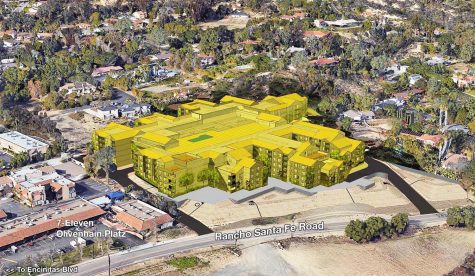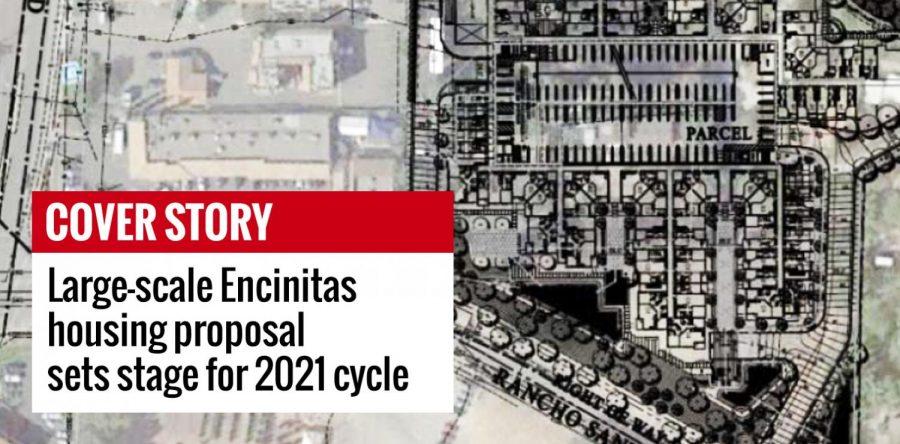Large-scale Encinitas housing proposal sets stage for 2021 cycle
The Encinitas Boulevard Apartments, a proposed housing development in Olivenhain, has sparked controversy among Encinitas residents. Some fear that the new housing will change the neighborhood’s character and cause traffic issues.
The project would add a 283-unit, seven-story apartment complex near Encinitas Boulevard and Rancho Santa Fe Road. Developer Randy Goodson has submitted several similar proposals since at least 2005.
In 2019, Goodson submitted another proposal and withdrew it that December over concerns about affordable housing laws and other “hurdles” he had to clear before approval, such as traffic studies. He reintroduced the project in both January and April 2020.
Goodson could not be reached for comment for this report.

“Rancho Santa Fe Road is the only through road and is wall to wall with commuter traffic in the mornings, even with the schools largely not in session,” said Dan Vaughn, the chair of Encinitas Residents for Responsible Development. “Adding that to traffic, a huge number will be commuting to the UTC area, and traffic from that intersection to I-5 is already backed up.”
Vaughn said he is also worried that a large housing complex in rural Olivenhain will “ruin the character of the neighborhood” and said the city should focus on projects close to public transportation, contributing fewer cars to traffic. Vaughn is also worried that the added traffic will slow down fire evacuations.
“People are scared that we’ll be trapped in a Paradise-like situation if a fire comes through,” he said.
While former Encinitas City Council member Lisa Shaffer said she was aware of the Goodson project, she did not have enough information to comment on it directly. In speaking about general housing issues and approaches in the city, Shaffer told the North Coast Current that Encinitas doesn’t have a specific look or feel because there’s already a diversity of housing in its communities, such as in Cardiff and Leucadia.
Instead of fighting high-density housing projects, Shaffer said, the community needs to work to ensure projects are well-designed.
“There are ways to blend in and there are ways to build projects that are hideous, which is what people need to focus on,” Shaffer said.
When it comes to Olivenhain, Shaffer said, there is heavy traffic on Rancho Santa Fe Road already, and it’s not reasonable to expect a new project to fix existing problems. What a new project can do is mitigate for additional impacts.
High-density housing such as the Goodson proposal is possible through changes to Encinitas’ housing element — the portion of the city’s general plan that governs housing creation.
Under state law, cities must adopt and update a housing element every eight years. Cities must also designate a certain number of housing units as affordable housing. In San Diego County, the San Diego Association of Governments determines how much affordable housing each city must provide.
In 2013, Encinitas voters approved Proposition A, which required voter approval of changes to the city’s planning and zoning policies. Residents were worried that a future City Council would allow higher density housing, which they believed would change the Encinitas’ small-town community feel and allow the city to listen to developer interests over residents.
In 2016 and 2018, the same fears led voters to reject ballot measures to amend the housing element for that eight-year housing cycle, leaving Encinitas out of compliance with state law.
As a result, tenants and developers sued the city. A judge decided to preempt Prop. A, suspending it until 2021 and allowing Encinitas to implement a compliant housing law without voter approval. As part of the new housing element, the City Council upzoned properties, including the site of the Goodson project, allowing for greater housing density.
Encinitas’ affordable housing woes are far from over, however.
The next housing cycle begins in 2021, and state law requires Encinitas to pass another housing policy. In order to avoid reliving 2016 and 2018, Encinitas sued supporters of Proposition A, asking a judge to overturn the measure so the city can approve the new policy without putting it on a ballot. In March 2020, the city named the California Department of Housing and Community Development in its action to get judicial guidance on the issue, according to a city statement.
This cycle, the city submitted its housing policy early for approval by the state. In August, the state’s Housing and Community Development department sent a letter to the city of Encinitas, saying the city needs to revise the new housing plan to include realistic affordable housing numbers; the plan overestimated the number of affordable housing units in several projects.
The Coast News reported that the city would likely have to increase housing density through more upzoning, which would increase the maximum density for some properties. But because the latest housing policy was just passed in 2019, Encinitas could reuse some projects used on the 2019 policy because they haven’t been constructed yet.
Encinitas Mayor Catherine Blakespear was unavailable for an interview, but she told the North Cost Current that Encinitas needs to comply with state laws “to avoid wasting taxpayers’ money in lawsuits we can’t win.”
“We need to provide the opportunity for a range of housing types that are accessible to all income levels so that we continue to have a vibrant and vital community,” Blakespear said.
Ethan Edward Coston is a local freelance writer. Follow him on Twitter @Ethan4Books.

(Story updated 01/01/2021 at 12:55 p.m.)
(Story updated 12/31/2020 at 8:30 p.m.)
encinitas current, cardiff current



